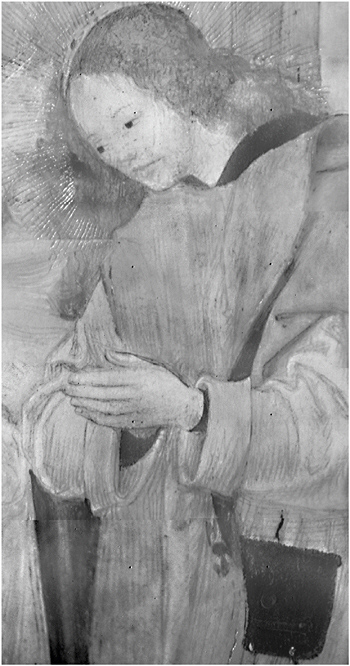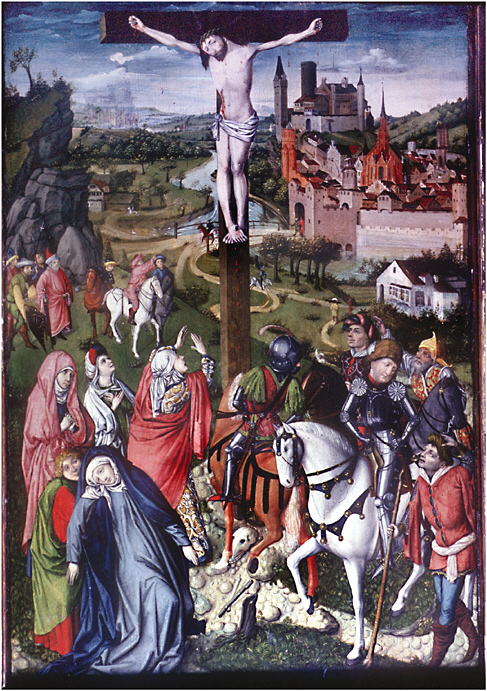Analytical Capabilities of Infrared Reflectography: An Art Historian’s Perspective
Molly Faries
Instituut voor Kunst-en Architectuurgeschiedenis
Rijksuniversiteit Groningen
Groningen, The Netherlands
Department of the History of Art
Indiana University
Bloomington, Indiana
ABSTRACT
The technique traditionally known as infrared reflectography (IRR) is today only one of many different possibilities for imaging in the infrared. Some cameras developed recently are focal plane arrays based on materials that were formerly classified, and they offer the option of using filters for broad- or narrowband imaging. This paper discusses the application of both traditional and newer cameras to the imaging and interpretation of the layered, pictorial stages of paintings. In many cases infrared can “see through” paint layers to the underdrawing, the layout drawing an artist makes before the application of color; a painting can then be understood in terms of compositional evolution from the layout to the surface. Layers that are opaque to infrared can also register, and may provide equally valuable information about the painting process. The paintings and drawings mentioned in this text derive from different art historical periods, from early Netherlandish paintings of the fifteenth and sixteenth centuries to works by later artists such as Rembrandt and Vincent Van Gogh. Researchers in this field now need to recognize the expanding capabilities of infrared imaging and at the same time define more precisely the appropriate parameters of its use.
As an imaging technique, infrared reflectography (IRR) is a method that allows sophisticated types of visual analysis. It accesses various stages in a work of art, particularly those that lie beneath the paint surface. Although it is also possible to obtain different responses of colors at different wave-
lengths in the infrared, the provisional identification of pigments that this phenomenon might allow will not be discussed here. Instead, this paper emphasizes infrared’s capacity to “see through” paint, as well as the opposite: infrared’s ability to detect paint layers that remain impervious to infrared light. The interpretation of the infrared imaging of paintings therefore depends on an informed reading of induced opacities and transparencies of paint.
The infrared vidicon is the device that has been used traditionally for IRR. This is hardly an emerging technology since it has been in continuous use in art history and conservation for nearly three decades. The method was developed in the late 1960s by the Dutch physicist, J. R. J. van Asperen de Boer, to improve upon the results of infrared photography (van Asperen de Boer, 1970). The advantages of IRR were immediately obvious at the time: The blues and greens that had remained opaque in infrared photography were rendered much more transparent, and underdrawings were revealed to a much greater extent. To date, almost all the results produced by this technique have been interpreted in the field of art history. In this application the IRR equipment rarely stays in the lab, but it is taken into the field (i.e., to museums, churches, and private collections). The infrared vidicon, housed in a high-resolution television camera, is portable, as is the television monitor, where the infrared image called a reflectogram can be viewed and documented by photography or captured to computer. The only additional equipment required is a source of illumination and a sturdy tripod. As a result, what has come to be known as the IRR expedition has been essential in gathering basic information about the working procedures of related artists or artistic groups.
INFRARED IMAGING DEVICES
In addition to the vidicon used in IRR, there are now perhaps as many as 15 other possibilities for imaging in the infrared. These range from inexpensive CCD (charge-coupled device) cameras with sensitivity close to that of visible light, some of which have been recommended for use in conservation (Meyer and Raquet, 2002), to more advanced focal plane arrays based on materials that were declassified in the 1990s, such as indium gallium arsenide or platinum silicide. Any of these imaging devices can be used with filters, but since the high-end focal plane arrays do not usually require as much increase in illumination when using filters, they can more easily be adapted to study works of art. If required, imaging can concentrate in narrow-wavelength bands, such as a range near 1100 nanometers (nm) for the visualization of brownish inks that quickly become transparent in infrared, or around 2 microns for the penetration of particularly opaque paints, such as malachite green. In practice multispectral imaging already exists, although it is not clear whether all users of infrared imaging sufficiently distinguish one
range of infrared from another, or exploit different ranges of infrared in the most appropriate manner. This is hardly surprising, since some of the cameras are so new that no established patterns of use have been developed.
This paper makes reference to infrared results from three different types of imaging devices. One is a camera that is sensitive closer to the range of infrared photography or the very near infrared: the MuSIS CCD camera, sensitive to around 1150 nm. (The MuSIS camera has a CCD sensor with 1024 x 768 resolution and a spectral response from 320 to 1150 nm, including two selectable ranges in the near infrared, from 700 to 950 nm and from 950 to 1150 nm.) The second is the “classic” IRR vidicon. (The IRR equipment used in this study is a Grundig 70 H television camera set at 875 lines and outfitted with a Hamamatsu N 214 infrared vidicon that works in a range from 900 to around 1600/2000 nm, a TV Macromar 1:2.8/36 mm lens, and Kodak 87 A filter, with a Grundig BG 12 monitor. Documentation is done with a Canon A-1 35 mm camera, a 50 mm Macrolens, and Kodak Plus X film. Currently the reflectogram negatives are digitized and assembled into composites using VIPs and/or Adobe Photoshop.) The third type of camera is the platinum silicide focal plane array: both the Mitsubishi M700 thermal imager and the European AEG Infrarot Module camera. (Both cameras are Stirling-cooled 640 × 480 platinum silicide focal plane arrays with digital and video output, outfitted with Nikon f 3.5, 55 mm lenses, so that the broadband spectral response ranges from 1.1 to 2.5-2.6 µm. For the Mitsubishi camera belonging to the Rijksuniversiteit Groningen, images are captured with Arte software and assembled with Panavue.) More information on the AEG camera has been published elsewhere (van der Weerd et al., 2001).
The vidicon and focal plane arrays have a spectral response much further in the infrared, and they can thus be categorized as devices that meet the specifications for infrared reflectography. These cameras all work in the region of infrared that has been determined by theoretical and experimental research to be essential for the optimum transparency of traditional nonsynthetic pigments. The work of J. R. J. van Asperen de Boer, as well as that done later by researchers at the National Gallery of Art in Washington, D.C., has determined that devices must be sensitive in the range around 2 µm—and more generally from 1.5 to 2 µm—for optimum penetration of paint and the visibility of most underdrawings (van Asperen de Boer, 1970; Walmsley et al., 1994).
EXAMPLES
The greatest penetration of paint has always been a prime requirement of IRR, along with high resolution of the imaging device. This was the case when the technique was developed with the objective of disclosing underdrawings, and this remains the case today. Although it is to a degree self-evident that these features would facilitate visual interpretation, several examples can further illustrate the types of reasoning that become possible when IRR imaging is optimized.
The IRR vidicon was used recently to study the painted wings of an early sixteenth-century altarpiece by Joos van Cleve (now in Warsaw, Museum Naradowe). (The painting was studied in the context of a Rijksuniversiteit Groningen research project, Painting in Antwerp Before Iconoclasm: A Socio-Economic Approach, funded by the Netherlands Organization for Scientific Research.) In this case IRR obtains what can be considered almost ideal results (see Figures 1 and 2). The different colors and color mixtures of the painted scenes become almost completely and uniformly transparent. This is true not only of blues and greens, which sometimes maintain more opacity, but also of whites, which if painted thickly, can block the penetration of infrared light. The infrared documents give one the sense of looking directly at the underdrawing without any interference from the paint. The only paint that continues to register has been mixed with dark or black pigments. The underdrawing of the altarpiece registers very clearly, since the underdrawing material, a dark black ink, is able to absorb infrared radiation strongly through the paint layers, as opposed to the white ground, which is highly reflective. The other panels in the altarpiece responded to infrared in a similar way, so that in this case IRR obtained both a complete and consistent record of the underdrawing in all 11 panels of the entire work. The type of underdrawing revealed can be considered representative of the master’s working method.
Many color notations were discovered in the underdrawing and since no colored area was obscured by paint, all the notations present were made visible, both for single colors and for color mixtures. These give an insight into the artist’s shop practice. They may have been directives to assistants and/or used to estimate how much of a certain color had to be ground and prepared for painting.
Because the overall underdrawing was revealed so clearly in terms of its type and function, it was possible to identify it more as an indicator of workshop routine than of a given artist’s personal drawing style. In this instance the master of the shop took over Albrecht Dürer’s woodcuts as models, probably for the woodcut’s more diagrammatic method of rendering form. This woodcut look has also been found in the underdrawings of other early sixteenth-century Antwerp masters, so that scholars in the field now recognize it as a production method that cuts across different shops. Such a carefully crafted drawing must represent a considerable investment of time and effort, whether or not it represents the work of the master of the shop or an assistant, who would have to be trained to reach a high degree of proficiency. This layout method must have been found useful as a way of facilitating the painting process, and would fit with the streamlining of workshop procedure that we know was occurring in Antwerp at the time.
A second example can demonstrate how high-resolution imaging can bring out the character of an underdrawing. Platinum silicide focal plane arrays are capable of very sharp images, equal to and sometimes better than the resolution of the best IRR vidicons (van der Weerd et al., 2001). A camera of this type was used to distinguish the very different underdrawings in two identical Madonna
and Child compositions from the workshop of the sixteenth-century Dutch painter, Jan van Scorel (Faries et al., 2000).
In the digital composites of one of the Madonnas a researcher can obtain a good visual sense of the material of the underdrawing, a dry black chalk, and the artist’s handling of it, which is remarkably free. The second Madonna displays an underdrawing that is entirely different: It seems to have been executed in a hesitant, painstaking manner, and it includes features that are based on fully realized forms of a preexisting model. When the underdrawings of both paintings are compared in their entirety, it becomes evident that there is a complicated compositional change in the first Madonna that is not repeated in the second. The pose of the Christ child was changed significantly between the underdrawing and paint stage of the freely underdrawn Madonna, while the Christ child’s pose in the second Madonna follows the paint surface of the first. These paintings are both products of the same shop. Nonetheless, the infrared comparison provides information about the sequence in which these paintings were made; the first of the Madonnas exhibits a more creative and idiosyncratic manner of working, while the execution of the second version adheres more tightly to predetermined motifs.
Many more examples of the interpretation of underdrawings can be found in the several surveys that have been published recently covering the extensive research that IRR has made possible in the last few decades (Faries, 2001). When IRR can be shown to provide clearly legible and reliable results, it gives basic validity to various types of studies. These can range from investigations of individual painters to more general studies of artistic production and painting technology.
Infrared results are not always as straightforward as the examples just mentioned, even if the imaging device has optimum resolution and penetration. The condition of a painting can always influence infrared results, and can greatly complicate the reading of infrared documents. (Infrared imaging, in fact, usually provides a great deal of information about the condition of paintings, the types of fills, and the extent of retouching.) Other factors can also have an effect, such as colored grounds and different underdrawing and painting materials. During an infrared examination, underdrawings that are very faint and/or executed in brownish pigments or other colors can become transparent along with the paint. This is a fairly well-known phenomenon, and can occur with any one of the infrared imaging devices currently available. Recent infrared study of a Nativity of Christ from the workshop of Jacob Cornelisz van Oostsanen (Utrecht, Centraal Museum) showed that while the underdrawing could be made visible by the vidicon IRR camera, it was rendered transparent by the broadband imaging of the Mitsubishi focal plane array (see Figures 3 and 4). Obtaining complete and representative material in this case would require a combination or cameras or the use of filters. If the camera allows the use of a variety of filters, one can work from broadband imaging back through ranges that come closer and closer to visible
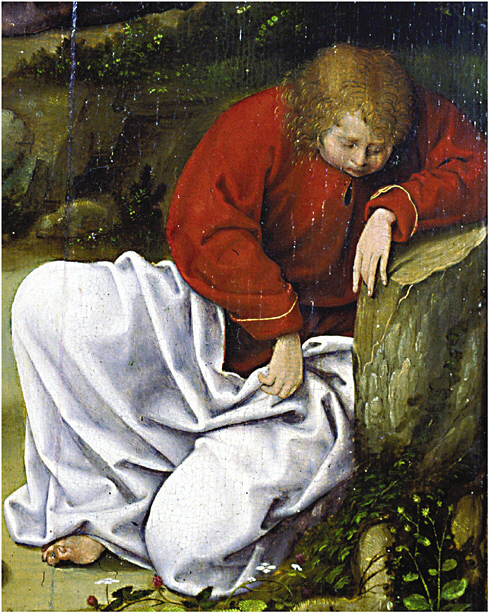
FIGURE 1 Joos van Cleve and workshop. Detail of Saint John the Evangelist in an altarpiece wing, Warsaw, Museum Naradowe (Photo: Micha Leeflang).
light until the underdrawing can be imaged. The drawback, however, is that the closer the imaging approaches visible light, the more opaque are greens, blues, and white, and the more restricted is the view of the underdrawing. Most infrared imaging, in fact, falls between the two extremes mentioned above and the case described here. Ideally IRR will render paint completely transparent and allow the
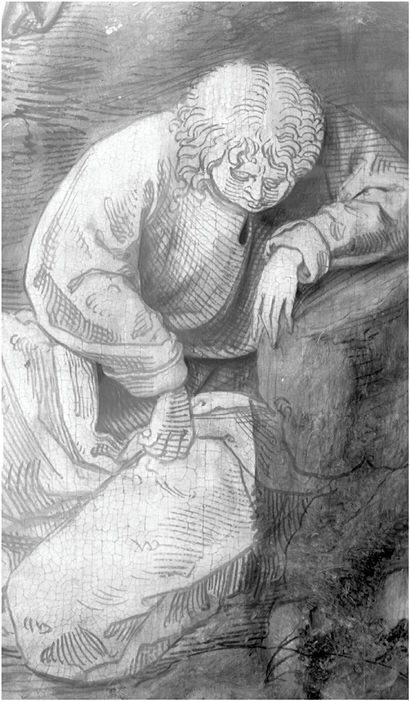
FIGURE 2 Same detail as Figure 1. Digital composite of IRR reflectograms at 0.9-1.6/2 µm, showing elaborately worked out underdrawing (IRR and digital composite: Molly Faries).
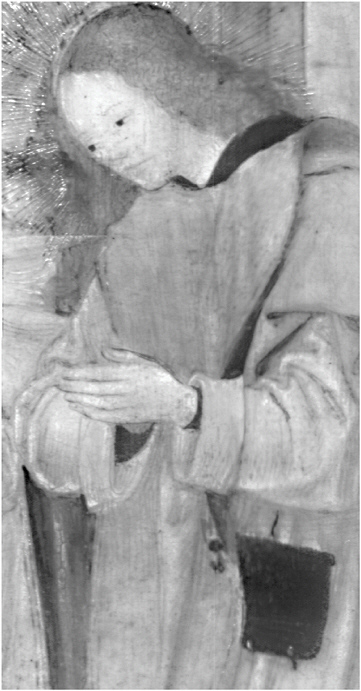
FIGURE 4 Same detail as Figure 3. Digital composite of IRR reflectograms at 1.1-2.5 µm in which the underdrawing becomes partially or totally transparent (IRR and digital composite: Molly Faries).
underdrawing to register strongly, while in the least responsive cases most of the paint will remain opaque and it will not be possible to visualize the underdrawing, if indeed it is present at all. Researchers must therefore always keep in mind that visibility of the underdrawing depends on a number of variable factors: the materials and technique of the underdrawing, the overlying pigment, and the spectral response of the detector (van Asperen de Boer, 1970; Walmsley et al., 1994).
Although imaging close to the range of visible light has its obvious drawbacks, there is one recent application that exploits the possibilities of the 700-1150 nm range. This concerns the infrared study of drawings on paper (and could apply equally well to archival documents and perhaps to illuminated manuscripts as well). The development of this examination method has been led by Hans Scholten of the Dutch company, Art Innovation, and should shortly appear in print (Havermans et al., 2003). In this type of study the MuSIS CCD camera captures a high-resolution color image in visible light and an image in the near infrared. These are then used to generate a false color infrared image using the color channels of Adobe Photoshop. Inks such as iron gall inks become transparent in this range of infrared light, but in false color infrared the differences in drawing materials and changes in condition can still be detected. Carbon black inks can be distinguished from iron gall ink; retouches can often be made visible and in some cases the presence of a corrosion product formed by iron gall ink can be detected. This is a promising area for further research, especially since the sensitivity of the MuSIS camera allows the low levels of illumination required for the study of works on paper or parchment. It must be emphasized, however, that this is an application for drawings that are not covered by paint.
There seems to be a prevailing notion that infrared reflectography is only useful for revealing underdrawings in paintings. If a researcher suspects that it will not be possible to make underdrawing visible, then the technique is simply ignored. Because infrared can see into the layers making up a painting, it can frequently reveal other equally valuable information about the painting process.
Changes are routinely made during the painting process; they can occur during the realization of the original image, or they may reflect changes made to the work after its completion. Many can be detected using such traditional methods as X-radiography, but many are easier to visualize in infrared. In these cases infrared imaging can work in exactly the same way it does when revealing underdrawings: The addition of black to the dark and grey portions of an underlying layer or form will absorb infrared and register. In this way unsuspected modifications and/or particular aspects of painting technique can be revealed. Ironically an imaging device that is optimized for the penetration of paint is still required. A researcher must be certain that infrared has revealed a “true” opacity and not one that is the result of using a camera whose sensitivity is too close to visible light.
Selected examples from Faries’s own research can illustrate some of the possibilities of this type of study. One concerns a small Crucifixion panel by an
anonymous fifteenth-century German master (Houston, Museum of Fine Arts). In the left background of the painting, colors of an underlying painted form show through the paint of the sky (see Figure 5). Further examination of this work revealed that the painting process was surprisingly complex, with some forms underdrawn that were later painted out, and then painted in again. Although X-radiography might seem the method of choice to elucidate these overlapping paint stages, infrared reflectography actually imaged some of the underlying forms in more detail. In X-ray the shape under the background sky could hardly be discerned (either because it was painted extremely thinly or with little dense paint, such as lead white), but in infrared the shape could be identified as a small castle painted on the horizon (see Figures 6 and 7). Because sufficient dark or black pigment was used in its execution, the gate, castle walls, and castle building and tower with crenellations, windows, and varying rooflines could all be distinguished (Faries, 1991).
Overpaintings can change not only the appearance of a painting but also its function, and sometimes occur when a new portrait is painted in over the image of an original donor. Other cases indicate a slightly more complicated situation: A work could be supplied with the intention of adding in portraits or coats of arms at a later date. We know now that altarpieces were occasionally ordered or bought on the art market with the middle panel completed but with the wings left blank, painted only with a dark, base color to protect the ground and wood. Infrared, of course, can detect this difference in ground color. In a triptych in the Catharijneconvent Museum in Utrecht, infrared study revealed that the image in the middle panel was built up from a light, reflective ground, while the portraits were added in over a dark underlying layer. The work was completed in two stages, and in its final form the altarpiece represents the work of two unrelated masters: an artist from Antwerp who painted the central scene and supplied the panels of the altarpiece and an Amsterdam master, Dirck Jacobszoon, who executed the portraits that were added to the wings (Faries, 2001).
In the same way, infrared can disclose other opacities that are part of developing painting techniques in the fifteenth and sixteenth centuries. In the sixteenth century, painters began to use dark pigments more and more frequently for shading and/or undermodeling. The painter Herri met de Bles is known to have used a gray layer as undermodeling for some of his blues. The infrared study of a landscape by this artist in the Cincinnati Museum of Art clearly singled out some blue drapery as an opaque dark form, while surrounding reds and greens became completely transparent. Further study clarified the infrared results: A cross section showed that the blue pigment, smalt, had been applied over a layer of black particles in a white matrix (Faries and Bonadies, 1998). Blue smalt on its own is known to become transparent in infrared. Developments of this nature eventually lead to the methods of seventeenth-century masters, such as Rubens, Jordaens, and others, and their use of an undermodeling paint stage that is often described as “dead coloring.”

FIGURE 6 X-radiograph detail of Figure 5 (Photo: Molly Faries).
Infrared has not been thought useful for the study of Rembrandt, but in the last few years it has become apparent that we need to look at Rembrandt’s paintings again. The recent IRR study of the painting known as Self-Portrait with Gorget (in the Mauritshuis in The Hague) revealed traces of underdrawing along with undermodeling. The underdrawn shapes and undermodeling have been interpreted by scholars as the result of compositional transfer, that is, a replication of the surface of another closely related portrait of Rembrandt that is in Nuremberg. This unexpected discovery has prompted a lively debate about the attribution of The Hague painting. Some scholars still believe both paintings are by Rembrandt, but others now consider the Nuremberg painting to be the authentic Rembrandt, and The Hague painting the work of a studio assistant or other anonymous seventeenth-century master (see articles by Edwin Buijsen, Jørgen Wadum, and Eric Jan Sluijter in the 2/4 issue of volume 114 [2000] of the journal Oud Holland). Still, at this point in time, little is known about comparable painting practices. The disclosure of the shaped layout of The Hague portrait
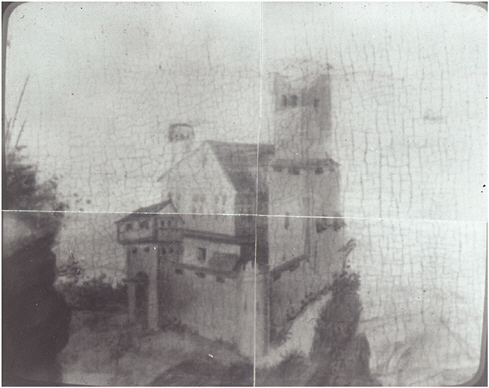
FIGURE 7 Same detail as Figure 5. IRR reflectogram assembly at .9-1.6/2 µm (IRR and assembly: Molly Faries).
suggests that infrared must be used more systematically in future technical studies of seventeenth-century paintings, and that the undermodeling stage must be taken more seriously.
The last examples derive from research in progress (fieldwork done with graduate students at the Rijksuniversiteit Groningen). They concern several paintings by Vincent Van Gogh, although the current findings would in theory apply to any painting with lighter colors on the surface and darker colors in underlying forms. It is now known that nearly a third of Van Gogh’s works were painted on top of previous compositions. Infrared reflectography, however, has rarely been applied to study this phenomenon, since it has generally been assumed Van Gogh’s paint would be too thick to reveal anything except the surface.
In one of the paintings studied, Interior of a Restaurant (Otterlo, Kröller-Müller Museum), it was not possible to image any of the underlying composition, but underdrawing was revealed. This took the form of a rectangular border with crossed diagonals, part of the perspective frame that Van Gogh is known to have used to lay out his paintings and drawings. This painting was studied using both
the MuSIS CCD camera and the Mitsubishi focal plane array. It was found that the underdrawing registered in infrared light accessed by both of the cameras, but the surface colors reflected infrared radiation in a completely different way.
Results were different in the second work studied, A Patch of Grass (Otterlo, Kröller-Müller Museum) (see Figure 8). Infrared reflectography was able to image underdrawing as well as dark painted forms at different levels in the painting (see Figure 9). The painted composition on the surface was found to be based on a perspective frame and was easily made visible with the Mitsubishi camera. This camera also disclosed some broad horizontal bands of paint near the center of the painting that have yet to be explained—as well as the darker and lighter shapes of an underlying form. Once the canvas was turned into an upright position, it was easy to recognize the form as a portrait of a woman, similar in appearance to portraits from the period of Van Gogh’s well-known Potato Eaters. The underlying portrait also registers in X-radiography. Both X-ray and infrared reveal the basic shape of the portrait, but the infrared image provides additional information about dark modeling strokes around the mouth and eyes and in the hair. In
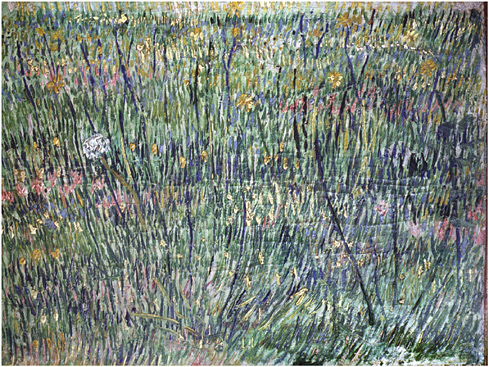
FIGURE 8 Vincent Van Gogh, A Patch of Grass, Otterlo, Kröller-Müller Museum. (Photo: Molly Faries).
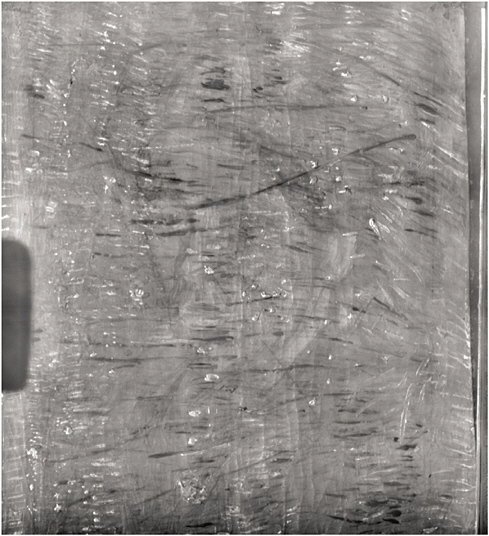
FIGURE 9 Detail of Figure 8. Digital composite of IRR reflectograms at 1.1-2.5 µm; a shadow from the easel appears on the left side (IRR and digital composite: Molly Faries).
this case infrared has imaged at least three unseen stages in the painting: an underlying composition, along with the forms of an as-yet-unidentified intermediate stage, and the perspective frame for the surface landscape, which has been applied over a presumably very thin layer of lead white.
CONCLUSION
Infrared reflectography is clearly a versatile technique. This paper has attempted to show how the method can facilitate art historical interpretation and how its
application may be extended for study beyond the disclosure of underdrawings. The research discussed here done with both the “classic” infrared vidicon and the newer focal plane arrays would indicate that there is reason to maintain the term “infrared reflectography” as a concept in infrared imaging. For the optimum penetration of paint and visibility of most underdrawings, devices that work beyond 1.5 µm and include the region around 2 µm are required. There are, none-theless, appropriate applications for devices that are only slightly sensitive in the infrared up to 1.1 µm.
Infrared reflectography has always had the advantage of being a portable, noninvasive scanning technique, and with new developments in the computerized assembly of reflectograms, it has become easier to document paintings in their entirety. If in coming years X-radiography were also developed as a portable scanning technique, the usefulness of both methods would be enhanced when applied concurrently. With such combined information about the overall evolution of a painting at hand, researchers would be in a better position to refine the questions and selection of methods required for further study, and for any sampling that might be required. One can also envision linking IRR and X-ray results with those from other portable methods that analyze the components of paint, such as X-ray fluorescence. Researchers would then be able to use integrated scanning systems to obtain a dimensional image of the stages of execution coupled with information from materials analysis of the paint surface.
The parameters of use for infrared imaging can be determined only by a combination of theoretical study and experiential research. The theoretical work that has already been done gives us a basic guide for infrared applications (van Asperen de Boer, 1970; Walmsley et al., 1994). Such work is essential in modeling the interrelationship of wavelength, pigments, grounds, and underdrawing materials. Nonetheless, reconstructions and test planks cannot replicate all the complexities of historical painting techniques in actual works. Nor can they approximate the effects of aging or the varied thicknesses and mixtures of paint. As indicated by the examples discussed in this text, infrared imaging can produce extremely varied results. It is up to the researcher to determine how to adapt and optimize the possibilities of infrared imaging as the examination unfolds. In addition, wavelength response itself is not always an absolute factor. Tests done with some indium gallium arsenide focal plane arrays have shown that the high quantum efficiency of these cameras can improve their performance (van Asperen de Boer, 2003). Systematic comparisons of the same paintings using different infrared imaging devices at different wavelength ranges should therefore be pursued, and this author has already begun to carry out such work. This research could produce a set of reference images that would help in establishing reasonable expectations for researchers and complement the already existing theoretical guidelines for infrared studies.
Infrared reflectography is becoming both more sophisticated and more technologically complex. Our current knowledge about the painting techniques of
different periods and different artists will undoubtedly need to be expanded. Analytical interpretation in this field depends on the expertise of the researcher, and can even be described as connoisseurship of technical documentation. There is thus every reason to pursue the systematic cataloguing of painting collections as well as larger comparative studies using infrared, and to encourage interdisciplinary research that combines the expertise of technical art historians with that of research-oriented painting conservators and scientists who have a nuanced understanding of art.
This text is based on the paper given at the Arthur M. Sackler colloquium, Scientific Examination of Art: Modern Techniques in Conservation and Analysis, held at the National Academy of Sciences, Washington, D.C., March 19-21, 2003. Molly Faries recently (September 2004) began a related research project: “Infrared Reflectography: Evaluative Studies,” part of the De Mayerne Research Programme on Molecular Studies in Conservation and Technical Studies in Art History funded by the Netherlands Organization for Scientific Research (NWO).
REFERENCES
Faries, M. 1991. Studying Underdrawings: Notes for the Cologne Workshop. Bloomington, Ind., § 1.212. (This reader, under copyright, is used by many who work in the field of technical studies in art history.)
Faries, M. 2001. Reshaping the field: The contribution of technical studies. In Early Netherlandish Painting at the Crossroads: A Critical Look at Current Methodologies, ed. M. W. Ainsworth, pp. 70-105. New York: Metropolitan Museum of Art.
Faries, M., and S. Bonadies. 1998. The Cincinnati Landscape with the Offering of Isaac by Herri met de Bles: Imagery and artistic strategies . In Herri met de Bles, Studies and Explorations of the World Landscape Tradition, eds. N. E. Muller, B. J. Rosasco, and J. H. Marrow, pp. 73-84. Turnhout: Art Museum of Princeton University in collaboration with Brepols Publishers.
Faries, M., L. Helmus, with contributions by J. R. J. van Asperen de Boer. 2000. The Madonnas of Jan van Scorel, Serial Production of a Cherished Motif (exhibition catalog). Utrecht: Centraal Museum.
Havermans, J., H. Abdul Aziz, and H. Scholten. Non-destructive detection of iron gall inks by means of multispectral imaging. Restaurator 24(2003) no. 1, pp. 55-60 and no. 2, pp. 88-94.
Meyer, M., and M. Raquet. 2002. Digitalfotografie für die Restaurierung Restauro 5:350-355.
van Asperen de Boer, J. R. J. 1970. Infrared Reflectography: A Contribution to the Examination of Earlier European Paintings, Ph.D. thesis, University of Amsterdam.
van Asperen de Boer, J. R. J. 2003. Slowly towards improved infrared reflectography equipment. In Recent Developments in the Technical Examination of Early Netherlandish Painting: Methodology, Limitations, and Perspectives (M. Victor Leventritt Symposium), ed. M. Faries and R. Spronk, pp. 57-64. Turnhout: Harvard University in collaboration with Brepols Publishers.
van der Weerd, J., R. M. A. Heeren, and J. R. J. van Asperen de Boer. 2001. A European 640 x 486 PtSi camera for infrared reflectography. In Colloque XIII pour l’étude du dessin sous-jacent et de la technologie dans la peinture: la peinture et le laboratoire: la peinture et le laboratoire, ed. R. Van Schoute and H. Verougstraete, pp. 231-243. Leuven: Uitgeverij Peeters.
Walmsley, E., C. Metzger, J. K. Delaney, and C. Fletcher. 1994. Improved visualization of underdrawings with solid-state detectors operating in the infrared. Studies in Conservation 39:217-231.





















